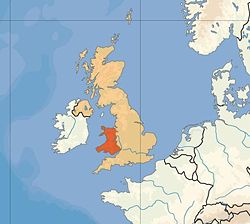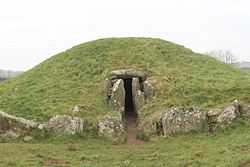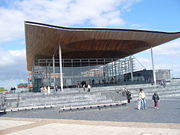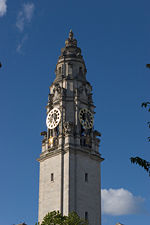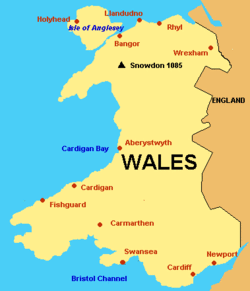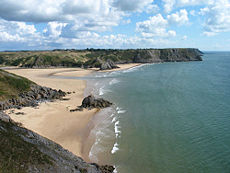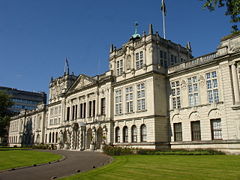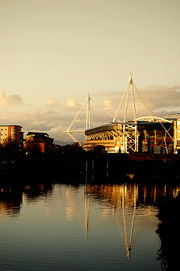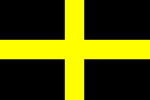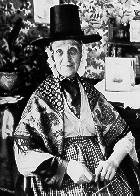Wales
2008/9 Schools Wikipedia Selection. Related subjects: Geography of Great Britain
| Cymru Wales
|
||||||
|---|---|---|---|---|---|---|
|
||||||
| Motto: Cymru am byth ( Welsh) "Wales Forever" |
||||||
| Anthem: " Hen Wlad Fy Nhadau" (English "Land of my fathers") |
||||||
|
Location of Wales (orange)
in the United Kingdom (camel) |
||||||
| Capital (and largest city) |
Cardiff, Caerdydd |
|||||
| National Languages | Welsh, English | |||||
| Demonym | Welsh, Cymry | |||||
| Government | Constitutional monarchy | |||||
| - | First Minister of Wales | Rhodri Morgan AM | ||||
| - | Deputy First Minister for Wales | Ieuan Wyn Jones AM | ||||
| - | Prime Minister (of the UK) | Gordon Brown MP | ||||
| - | Secretary of State (in the UK government) | Paul Murphy MP | ||||
| - | Queen (of the UK) | Queen Elizabeth II | ||||
| Unification | ||||||
| - | by Gruffudd ap Llywelyn | 1056 | ||||
| Area | ||||||
| - | Total | 20,779 km² 8,022 sq mi |
||||
| Population | ||||||
| - | 2008 estimate | 3,004,6001 | ||||
| - | 2001 census | 2,903,085 | ||||
| - | Density | 140/km² 361/sq mi |
||||
| GDP ( PPP) | 2006 (for national statistics) estimate | |||||
| - | Total | US$85.4 billion | ||||
| - | Per capita | US$30,546 | ||||
| HDI (2003) | 0.939 (high) | |||||
| Currency | Pound sterling ( GBP) |
|||||
| Time zone | GMT ( UTC0) | |||||
| - | Summer ( DST) | BST ( UTC+1) | ||||
| Internet TLD | .uk2 | |||||
| Calling code | +44 | |||||
| Patron saint | David, Dewi | |||||
| 1 | Office for National Statistics - UK population grows to more than 60 million | |||||
| 2 | Also .eu, as part of the European Union. ISO 3166-1 is GB, but .gb is unused. | |||||
Wales [weɪlz] ( Welsh: Cymru; pronounced /ˈkəmrɨ/ ) is a country which is part of the United Kingdom, bordering England to its east, and the Atlantic Ocean and Irish Sea to its west. Wales has a population estimated at three million and is a bilingual country, with English spoken by the majority of the people, and Welsh by approximately 20%.
Traditionally one of the six Celtic nations, a distinct Welsh national identity emerged in the early fifth century, after the Roman withdrawal from Britain. The 13th-century defeat of Llewelyn by Edward I completed the Anglo-Norman conquest of Wales and brought about centuries of English occupation. Wales was eventually annexed to England with the Laws in Wales Acts 1535–1542, creating the legal entity known today as England and Wales. Distinctive Welsh politics developed in the 19th century eventually leading to devolution and the creation of the National Assembly for Wales in 1999, which holds responsibility for a range of devolved matters.
The capital Cardiff (Caerdydd) is Wales' largest city with 317,500 people. For a period it was the biggest coal port in the world. Two-thirds of the Welsh population live in South Wales, with another concentration in eastern North Wales. The Encyclopedia of Wales notes that many travellers and tourists have been drawn to Wales' "wild... and picturesque" landscapes. From the late 19th century onwards, Wales acquired its popular image as the "land of song", attributable in part to the revival of the eisteddfod tradition. Actors, singers and other artists are celebrated in Wales today, often achieving international success, and Cardiff is the home of the largest media centre in the UK outside of London.
Wales is sometimes referred to as a principality. Llywelyn the Great founded the Principality of Wales in 1216, and following the Edwardian Conquest, Owain Glyndŵr briefly restored its independence in the early 15th century. Traditionally the British Royal Family have bestowed the courtesy title of ' Prince of Wales' upon the heir apparent of the reigning monarch.
Etymology
The English name "Wales" originates from the Germanic word Walha, meaning "foreigner," probably derived from the term Volcae. The term also appears in the "-wall" of Cornwall. The Welsh call their country Cymru in the Welsh language, which most likely meant "compatriots" in Old Welsh. The name competed for a long time in Welsh literature with the older name Brythoniaid ( Brythons). Only after 1100 did the former become as common as the latter; both terms applied originally not only to the inhabitants of what is now called Wales, but in general to speakers of the Brythonic language and its descendants, many of whom lived in " the Old North": the placenames Cymru (Welsh for Wales) and Cumbria are of the same origin. The Angles, Saxons and Jutes were known indiscriminately as Saeson in Welsh (the term is cognate with "Saxon"; compare Gaelic Sassenach); Sais, plural Saeson, is the modern Welsh word for "Englishman."
There is also a medieval legend found in the Historia Regum Britanniae of Sieffre o Fynwy ( Geoffrey of Monmouth) that derives it from the name Camber, son of Brutus and, according to the legend, the eponymous King of Cymru ( Cambria in Latin); this, however, is considered largely the fruit of Geoffrey's vivid imagination. Cumberland and Cumbria in the North of England derive their names from the same Old Welsh word.
History
Colonisation
The first documented history was recorded during the Roman occupation of Britain. At that time the area of modern Wales was divided into many tribes, of which the Silures in the south-east and the Ordovices in the central and north-west areas were the largest and most powerful.
A string of Roman forts were established across what is now South Wales, as far west as Carmarthen (Caerfyrddin; Latin: Maridunum), and gold was mined at Dolaucothi in Carmarthenshire. There is evidence that the Romans progressed even farther west. They also built the Roman legionary fortress at Caerleon (Latin: Isca Silurum), of which the magnificent amphitheatre is the best preserved in Britain. The Romans were also busy in Northern Wales, and the mediaeval Welsh tale Breuddwyd Macsen Wledig (dream of Macsen Wledig) claims that Magnus Maximus (Macsen Wledig), one of the last western Roman Emperors, married Elen or Helen, the daughter of a Welsh chieftain from Segontium, present-day Caernarfon. It was in the 4th century during the Roman occupation that Christianity was introduced to Wales.
After the Roman withdrawal from Britain in 410, much of the lowlands were overrun by various Germanic tribes. However, Gwynedd, Powys, Dyfed and Seisyllg, Morgannwg, and Gwent emerged as independent Welsh successor states. They endured, in part because of favourable geographical features such as uplands, mountains, and rivers and a resilient society that did not collapse with the end of the Roman civitas.
-
-
- The Saxons at anchor on the sea always
- The Cymry venerable until doomsday shall be supreme
- They will not seek books nor be covetous of poets
- The presage of this isle will be no other than this.
- [ from The Omen of Prydein The Great, Book of Taliesin VI ]
- The Cymry venerable until doomsday shall be supreme
- The Saxons at anchor on the sea always
-
This tenacious survival by the Romano-Britons and their descendants in the western kingdoms was to become the foundation of what we now know as Wales. With the loss of the lowlands, England's kingdoms of Mercia and Northumbria, and later Wessex, wrestled with Powys, Gwent, and Gwynedd to define the frontier between the two peoples.
Having lost much of the West Midlands to Mercia in the sixth and early seventh centuries, a resurgent late-seventh-century Powys checked Mercian advancement. Aethelbald of Mercia, looking to defend recently acquired lands, had built Wat's Dyke. According to John Davies, this endeavour may have been with Powys king Elisedd ap Gwylog's own agreement, however, for this boundary, extending north from the valley of the River Severn to the Dee estuary, gave Oswestry (Welsh: Croesoswallt) to Powys. King Offa of Mercia seems to have continued this consultative initiative when he created a larger earthwork, now known as Offa's Dyke (Welsh: Clawdd Offa). Davies wrote of Cyril Fox's study of Offa's Dyke:
In the planning of it, there was a degree of consultation with the kings of Powys and Gwent. On the Long Mountain near Trelystan, the dyke veers to the east, leaving the fertile slopes in the hands of the Welsh; near Rhiwabod, it was designed to ensure that Cadell ap Brochwel retained possession of the Fortress of Penygadden." And for Gwent Offa had the dyke built "on the eastern crest of the gorge, clearly with the intention of recognizing that the River Wye and its traffic belonged to the kingdom of Gwent.
Offa's Dyke largely remained the frontier between the Welsh and English, though the Welsh would recover by the 12th century the area between the Dee and the Conwy known then as the Perfeddwlad. By the eighth century, the eastern borders with the Anglo-Saxons had broadly been set.
Following the successful examples of Cornwall in 722 and Brittany in 865, the Britons of Wales made their peace with the Vikings and asked the Norsemen to help the Britons fight the Anglo-Saxons of Mercia to prevent an Anglo-Saxon conquest of Wales. In 878 AD the Britons of Wales unified with the Vikings of Denmark to destroy an Anglo-Saxon army of Mercians. Like Cornwall in 722, this decisive defeating of the Saxons gave Wales some decades of peace from Anglo-Saxon attack. In 1063, the Welsh prince Gruffydd ap Llywelyn made an alliance with Norwegian Vikings against Mercia which, as in 878 AD was successful, and the Saxons of Mercia defeated. As with Cornwall and Brittany, Viking aggression towards the Saxons/Franks ended any chance of the Anglo-Saxons/Franks conquering their Celtic neighbours.
Medieval Wales
The southern and eastern lands lost to English settlement became known in Welsh as Lloegyr (Modern Welsh Lloegr), which may have referred to the kingdom of Mercia originally, and which came to refer to England as a whole. The Germanic tribes who now dominated these lands were invariably called Saeson, meaning " Saxons". The Anglo-Saxons, in turn, labelled the Romano-British as Walha, meaning 'foreigner' or 'stranger'. The Welsh continued to call themselves Brythoniaid (Brythons or Britons) well into the Middle Ages, though the first use of Cymru and y Cymry is found as early as 633 in the Gododdin of Aneirin. In Armes Prydain, written in about 930, the words Cymry and Cymro are used as often as 15 times. It was not until about the 12th century however, that Cymry began to overtake Brythoniaid in their writings.
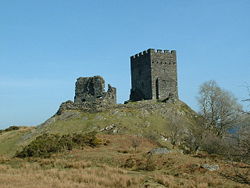
From the year 800 onwards, a series of dynastic marriages led to Rhodri Mawr's (r. 844-877) inheritance of Gwynedd and Powys. His sons in turn would found three principal dynasties ( Aberffraw for Gwynedd, Dinefwr for Deheubarth, and Mathrafal for Powys), each competing for hegemony over the others. Rhodri's grandson Hywel Dda (r.900-950) founded Deheubarth out of his maternal and paternal inheritances of Dyfed and Seisyllwg, ousted the Aberffraw dynasty from Gwynedd and Powys, and codified Welsh law in 930, finally going on a pilgrimage to Rome (and allegedly having the Law Codes blessed by the Pope). Maredudd ab Owain (r.986-999) of Deheubarth (Hywel's grandson) would, (again) temporarily oust the Aberffraw line from control of Gwynedd and Powys. Maredudd's great-grandson (through his daughter Princess Angharad) Gruffydd ap Llywelyn (r.1039-1063) would conquer his cousins' realms from his base in Powys, and even extend his authority into England. Owain Gwynedd (1100-1170) of the Aberffraw line was the first Welsh ruler to use the title princeps Wallensium (prince of the Welsh), a title of substance given his victory on the Berwyn Mountains, according to historian John Davies. The Aberffraw dynasty would surge to pre-eminence with Owain Gwynedd's grandson Llywelyn Fawr (the Great) (b.1173-1240), wrestling concessions out of the Magna Carta in 1215 and receiving the fealty of other Welsh lords in 1216 at the council at Aberdyfi, becoming the first Prince of Wales. His grandson Llywelyn II also secured the recognition of the title Prince of Wales from Henry III with the Treaty of Montgomery in 1267. Later however, a succession of disputes, including the imprisonment of Llywelyn's wife Eleanor, daughter of Simon de Montfort, culminated in the first invasion by Edward I. As a result of military defeat, the Treaty of Aberconwy exacted Llywelyn's fealty to England in 1277. Peace was short lived and with the 1282 Edwardian conquest the rule of the Welsh princes permanently ended. With Llywelyn's death and his brother prince Dafydd's execution, the few remaining Welsh lords did homage for their lands to Edward I. Llywelyn's head was then carried through London on a spear; his baby daughter Gwenllian was locked in the priory at Sempringham, where she remained until her death fifty four years later.
To help maintain his dominance, Edward constructed a series of great stone castles. Beaumaris, Caernarfon, and Conwy were built mainly to overshadow the Welsh royal home and headquarters Garth Celyn, Aber Garth Celyn, on the north coast of Gwynedd.
There was no major uprising except that led by Owain Glyndŵr a century later, against Henry IV of England. In 1404 Owain was reputedly crowned Prince of Wales in the presence of emissaries from France, Spain and Scotland; he went on to hold parliamentary assemblies at several Welsh towns, including Machynlleth. The rebellion was ultimately to founder, however, and Owain went into hiding in 1412, with peace being more or less restored in Wales by 1415.
Although the English conquest of Wales took place under the 1284 Statute of Rhuddlan, a formal Union did not occur until 1536, shortly after which Welsh law, which continued to be used in Wales after the conquest, was fully replaced by English law under the Laws in Wales Acts 1535-1542.
Nationalist revival
In the 20th century, Wales saw a revival in its national status. Plaid Cymru was formed in 1925, seeking greater autonomy or independence from the rest of the UK. In 1955, the term England and Wales became common for describing the area to which English law applied, and Cardiff was proclaimed as capital city. In 1962 the Welsh Language Society (Cymdeithas yr Iaith Gymraeg) was formed in response to fears that the language might soon die out. Nationalism grew, particularly following the flooding of the Tryweryn valley in 1965, drowning the village of Capel Celyn to create a reservoir supplying water to Liverpool. In 1966 the Carmarthen Parliamentary seat was won by Plaid Cymru at a by-election, their first Parliamentary seat. A terror campaign was waged for a short period by the Free Wales Army and Mudiad Amddiffyn Cymru (MAC - Welsh Defence Movement). In the years leading up to the investiture of Prince Charles as Prince of Wales in 1969, these groups were responsible for a number of bomb blasts destroying water pipes and tax and other offices. In 1967, the Wales and Berwick Act 1746 was repealed for Wales, and a legal definition of Wales, and of the boundary with England was stated.
A referendum on the creation of an assembly for Wales in 1979 (see Wales referendum, 1979) led to a large majority for the "no" vote. However, in 1997 a referendum on the same issue secured a "yes", although by a very narrow majority. The National Assembly for Wales (Cynulliad Cenedlaethol Cymru) was set up in 1999 (as a consequence of the Government of Wales Act 1998) and possesses the power to determine how the central government budget for Wales is spent and administered (although the UK parliament reserves the right to set limits on the powers of the Welsh Assembly). The 1998 Act was amended by the Government of Wales Act 2006 which enhanced the Assembly's powers, giving it legislative powers akin to the Scottish Parliament and Northern Ireland Assembly. Following the 2007 Assembly election, the One Wales Government was formed under a coalition agreement between Plaid Cymru and the Welsh Labour Party, under that agreement, a convention is due to be established to discuss further enhancing Wales' legislative and financial autonomy. A referendum on giving the Welsh assembly full law-making powers is promised "as soon as practicable, at or before the end of the assembly term (in 2011)" and both parties have agreed "in good faith to campaign for a successful outcome to such a referendum".
Government and Politics
The head of state in Wales, a constituent part of the United Kingdom, is the British monarch, currently Queen Elizabeth II (since 1952). Executive power is derived by the Queen, and exercised by the Parliament of the United Kingdom at Westminster, with some powers devolved to the National Assembly for Wales in Cardiff. The United Kingdom Parliament retains responsibility for passing primary legislation in Wales. The National Assembly has regulatory authority over laws passed that are applicable to Wales, and has limited power to vary these by secondary legislation. The National Assembly is not a sovereign authority, and the UK Parliament could, in theory, overrule or even abolish it at any time. However, its powers increased under the Government of Wales Act 2006 which allows it to speed up the passage of 'Assembly Measures'.
The National Assembly was first established in 1998 under the Government of Wales Act. There are 60 members of the Assembly, known as " Assembly Members (AM)". Forty of the AMs are elected under the First Past the Post system, with the other 20 elected via the Additional Member System via regional lists in 5 different regions. The largest party elects the First Minister of Wales, who acts as the head of government. The Welsh Assembly Government is the executive arm, and the Assembly has delegated most of its powers to the Assembly Government. The new Assembly Building designed by Lord Rogers was opened by The Queen on St David's Day (March 1) 2006.
The current First Minister of Wales is Rhodri Morgan (since 2000), of the Welsh Labour party, with 26 of 60 seats. After the National Assembly for Wales election, 2007 Welsh Labour and Plaid Cymru; The Party of Wales, which favours Welsh independence from the rest of the United Kingdom entered into a coalition partnership to form a stable government with the "historic" One Wales agreement. As the second largest party in the Assembly with 15 out of 60 seats, Plaid Cymru is currently led by Ieuan Wyn Jones, now the Deputy First Minister of Wales. The presiding officer of the Assembly is Plaid Cymru member Lord Elis-Thomas. Other parties include the Conservative Party, currently the loyal opposition with 12 seats, and the Liberal Democrats with six seats. The "LibDems" had previously formed part of a coalition government with Labour in the first Assembly. There is one independent member.
In the British House of Commons, Wales is represented by 40 MPs (out of a total of 646) in the Welsh constituencies. Currently, Welsh Labour represents 29 of the 40 seats, the Liberal Democrats hold four seats, Plaid Cymru three and the Conservatives three. A Secretary of State for Wales sits in the UK cabinet and is responsible for representing matters that pertain to Wales. The Wales Office is a department of the United Kingdom government, responsible for Wales. The current Secretary of State for Wales is Paul Murphy, who replaced Peter Hain on 24 January 2008 over an investigation on undeclared donations.
Local government
The traditional counties of Wales have changed over the years. For the purposes of local government, Wales was divided into 22 council areas in 1996. These " unitary authorities" are responsible for the provision of all local government services. There are five cities in Wales: Bangor, Cardiff (the capital), Newport, St David's and Swansea.
Map of Unitary authorities
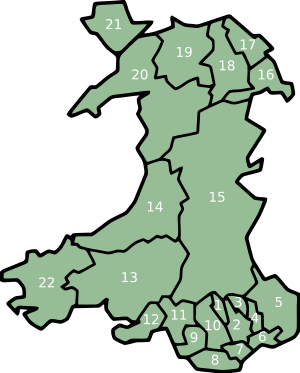 |
|
Areas are Counties, unless marked * (for Cities) or † (for County Boroughs). Welsh language forms are given in parentheses, where they differ from the English.
|
||||||||||||||||||||||||||||||||||
Law
England fully annexed Wales under the Laws in Wales Act 1535, in the reign of King Henry VIII. Prior to that Welsh Law had survived de facto after the conquest up to the 15th century in areas remote from direct English control. The Wales and Berwick Act 1746 provided that all laws that applied to England would automatically apply to Wales (and Berwick-upon-Tweed, a town located on the Anglo-Scottish border) unless the law explicitly stated otherwise. This act, with regard to Wales, was repealed in 1967. However, Wales and England, as part of a single legal entity, share the same legal system — except for a few changes to accommodate the autonomy recently afforded to Wales. In this sense, English law is the law of Wales. (See England and Wales.)
English law is regarded as a common law system, with no major codification of the law, and legal precedents are binding as opposed to persuasive. The court system is headed by the House of Lords which is the highest court of appeal in the land for criminal and civil cases (although this is due to be replaced by a Supreme Court of the United Kingdom). The Supreme Court of Judicature of England and Wales is the highest court of first instance as well as an appellate court. The three divisions are the Court of Appeal; the High Court of Justice and the Crown Court. Minor cases are heard by the Magistrates' Courts or the County Court.
Since devolution in 2006, the Welsh Assembly has had the authority to draft and approve some laws outside of the UK Parliamentary system to meet the specific needs of Wales. Under powers conferred by Legislative Competency Orders agreed by all parliamentary stakeholders, it is able to pass laws known as Assembly Measures in relation to specific fields, such as health and education. As such, Assembly Measures are a subordinate form of primary legislation, lacking the scope of UK-wide Acts of Parliament, but able to be passed without the approval of the UK parliament or Royal Assent for each 'act'. Through this primary legislation, the Welsh Assembly Government can then also draft more specific secondary legislation. With devolution, the ancient and historic Wales and Chester court circuit was also disbanded and a separate Welsh court circuit was created to allow for any Measures passed by the Assembly.
Geography
Wales is located on a peninsula in central-west Great Britain. Its area, the size of Wales, is about 20,779 km² (8,023 square miles - about the same size as Massachusetts, Slovenia or El Salvador and about a quarter of the size of Scotland). It is about 274 km (170 miles) north- south and 97 km (60 miles) east- west. Wales is bordered by England to the east and by sea in the other three directions: the Môr Hafren (Bristol Channel) to the south, St. George's Channel to the west, and the Irish Sea to the north. Altogether, Wales has over 1,200 km (750 miles) of coastline. There are several islands off the Welsh mainland, the largest being Ynys Môn (Anglesey) in the northwest.
The main population and industrial areas are in South Wales, consisting of the cities of Cardiff (Caerdydd), Swansea (Abertawe) and Newport (Casnewydd) and surrounding areas, with another significant population in the north-east around Wrexham (Wrecsam).
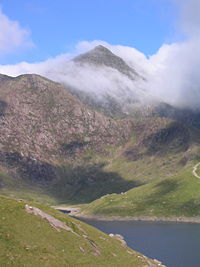
Much of Wales' diverse landscape is mountainous, particularly in the north and central regions. The mountains were shaped during the last ice age, the Devensian glaciation. The highest mountains in Wales are in Snowdonia (Eryri), and include Snowdon (Yr Wyddfa), which, at 1085 m (3,560 ft) is the highest peak in Wales. The 14 (or possibly 15) Welsh mountains over 3,000 feet (914 m) high are known collectively as the Welsh 3000s. The Brecon Beacons (Bannau Brycheiniog) are in the south (highest point Pen-y-Fan 886 m (2,907 ft)), and are joined by the Cambrian Mountains in Mid Wales, the latter name being given to the earliest geological period of the Paleozoic era, the Cambrian.
In the mid 19th century, two prominent geologists, Roderick Murchison and Adam Sedgwick, used their studies of the geology of Wales to establish certain principles of stratigraphy and palaeontology. After much dispute, the next two periods of the Paleozoic era, the Ordovician and Silurian, were named after ancient Celtic tribes from this area. The older rocks underlying the Cambrian rocks were referred to as Pre-cambrian.
Wales has three National Parks: Snowdonia, Brecon Beacons and Pembrokeshire Coast. It also has four Areas of Outstanding Natural Beauty. These areas include Anglesey, the Clwydian Range, the Gower peninsula and the Wye Valley. The Gower peninsula was the first area in the whole of the United Kingdom to be designated as an Area of Outstanding Natural Beauty, in 1956.
Along with its Celtic cousins in Cornwall, the coastline of South and West Wales has more miles of Heritage Coast than anywhere else. The coastline of the Glamorgan Heritage Coast, the Gower peninsula, Pembrokeshire, Carmarthenshire, and Ceredigion is particularly wild and impressive. Gower, Carmarthenshire, Pembrokeshire and Cardigan Bay all have clean blue water, white sand beaches and impressive marine life. Despite this scenic splendour the coast of Wales has a dark side; the south and west coasts of Wales, along with the Irish and Cornish coasts, are frequently blasted by huge Atlantic westerlies/south westerlies that, over the years, have sunk and wrecked many vessels. On the night of October 25, 1859, 114 ships were destroyed off the coast of Wales when a hurricane blew in from the Atlantic; Cornwall and Ireland also had a huge number of fatalities on its coastline from shipwrecks that night. Wales has the somewhat unenviable reputation, along with Cornwall, Ireland and Brittany, of having per square mile, some of the highest shipwreck rates in Europe. The shipwreck situation was particularly bad during the industrial era when ships bound for Cardiff got caught up in Atlantic gales and were decimated by "the cruel sea".
Like Cornwall, Brittany and Ireland, the clean, clear waters of South-west Wales of Gower, Pembrokeshire and Cardigan Bay attract marine visitors including basking sharks, Atlantic grey seals, leatherback turtles, dolphins, porpoises, jellyfish, crabs and lobsters. Pembrokeshire and Ceredigion in particular are recognised as an area of international importance for Bottlenose dolphins, and New Quay in the middle of Cardigan Bay has the only summer residence of bottle nosed dolphins in the whole of the U.K.
The modern border between Wales and England was largely defined in the 16th century, based on medieval feudal boundaries. The boundary line (which very roughly follows Offa's Dyke up to 40 miles (64 km) of the northern coast) separates Knighton from its railway station, virtually cuts off Church Stoke from the rest of Wales, and slices straight through the village of Llanymynech (where a pub actually straddles the line).
The Seven Wonders of Wales is a list in doggerel verse of seven geographic and cultural landmarks in Wales probably composed in the late 18th century under the influence of tourism from England. All the "wonders" are in north Wales: Snowdon (the highest mountain), the Gresford bells (the peal of bells in the medieval church of All Saints at Gresford), the Llangollen bridge (built in 1347 over the River Dee, Afon Dyfrdwy), St Winefride's Well (a pilgrimage site at Holywell, Treffynnon) in Flintshire), the Wrexham (Wrecsam) steeple (16th century tower of St. Giles Church in Wrexham), the Overton Yew trees (ancient yew trees in the churchyard of St. Mary's at Overton-on-Dee) and Pistyll Rhaeadr (Wales' tallest waterfall, at 240 ft (73 m)). The wonders are part of the rhyme:
- Pistyll Rhaeadr and Wrexham steeple,
- Snowdon's mountain without its people,
- Overton yew trees, St Winefride's Wells,
- Llangollen bridge and Gresford bells.
- Snowdon's mountain without its people,
Climate
- Highest maximum temperature: 35.2 °C (95.4 °F) at Hawarden Bridge, Flintshire on 2 August 1990.
- Lowest minimum temperature: -23.3 °C (-10 °F) at Rhayader, Radnorshire on 21 January 1940.
- Maximum number of hours of sunshine in a month: 354.3 hours at Dale Fort, Pembrokeshire in July 1955.
- Minimum number of hours of sunshine in a month: 2.7 hours at Llwynon, Brecknockshire in January 1962.
- Maximum rainfall in a day (0900 UTC - 0900 UTC): 211 mm (8.30 inches) at Rhondda, Glamorgan, on 11 November 1929.
Economy
Parts of Wales have been heavily industrialised since the 18th century and the early Industrial Revolution. Coal, copper, iron, silver, lead, and gold have been extensively mined in Wales, and slate has been quarried. By the second half of the 19th century, mining and metallurgy had come to dominate the Welsh economy, transforming the landscape and society in the industrial districts of south and north-east Wales.
From the early 1970s, the Welsh economy faced massive restructuring with large numbers of jobs in traditional heavy industry disappearing and being replaced eventually by new ones in light industry and in services. Over this period Wales was successful in attracting an above average share of foreign direct investment (FDI) in the UK. However, much of the new industry has essentially been of a 'branch factory' type, often routine assembly employing low skilled workers.
Wales has struggled to develop or attract high value-added employment in sectors such as finance and research and development, attributable in part to a comparative lack of economic mass (i.e. population) - Wales lacks a large metropolitan centre and most of the country, except south east Wales, is sparsely populated. The lack of high value-added employment is reflected in lower economic output per head relative to other regions of the UK - in 2002 it stood at 90% of the EU25 average and around 80% of the UK average. However, care is needed in interpreting these data, which do not take account of regional differences in the cost of living. The gap in real living standards between Wales and more prosperous parts of the UK is not pronounced.
In 2002, the Gross Domestic Product (GDP) of Wales was just over £26 billion ($48 billion), giving a per capita GDP of £12,651 ($19,546). As of 2006, the unemployment rate in Wales stood at 5.7% - above the UK average, but lower than in the majority of EU countries.
Due to poor-quality soil, much of Wales is unsuitable for crop-growing, and livestock farming has traditionally been the focus of agriculture. The Welsh landscape (protected by three National Parks) and 42 Blue Flag beaches, as well as the unique culture of Wales, attract large numbers of tourists, who play an especially vital role in the economy of rural areas. See Tourism in Wales.
Healthcare
Public healthcare in Wales is provided by NHS Wales which was originally formed as part of the same NHS structure created by the National Health Service Act 1946 but with powers over the NHS in Wales coming under the Secretary of State for Wales in 1969. In turn, responsibility for NHS Wales was passed to the Welsh Assembly and Executive under devolution in 1999. NHS Wales provides public healthcare in Wales and employs some 90,000 staff, making it Wales’ biggest employer.The Minister for Health and Social Services is the person within the Welsh Assembly Government who holds cabinet responsibilities for both health and social care in Wales.
Demography
The population of Wales in the United Kingdom Census 2001 was 2,903,085, which has risen to 2,958,876 according to 2005 estimates. This would make Wales the 132nd largest country by population if it were a sovereign state.
According to the 2001 census, 96% of the population was White British, and 2.1% non-white (mainly of Asian origin). Most non-white groups were concentrated in the southern port cities of Cardiff, Newport and Swansea. Welsh Asian communities developed mainly through immigration since World War II. More recently, parts of Wales have seen an increased number of immigrants settle from recent EU accession countries such as Poland - although some Poles also settled in Wales in the immediate aftermath of World War II.

In the 2001 Labour Force Survey, 72% of adults in Wales considered their national identity as wholly Welsh and another 7% considered themselves to be partly Welsh (Welsh and British were the most common combination). A recent study estimated that 35% of the Welsh population have surnames of Welsh origin (5.4% of the English population and 1.6% of the Scottish also bore 'Welsh' names). However, some names identified as English (such as 'Greenaway') may be corruptions of Welsh ('Goronwy'). Other names common in Wales, such as 'Richards', may have originated simultaneously in other parts of Britain.
In 2001 a quarter of the Welsh population were born outside Wales, mainly in England; about 3% were born outside the UK. The proportion of people who were born in Wales differs across the country, with the highest percentages in the South Wales Valleys, and the lowest in Mid Wales and parts of the north-east. In both Blaenau Gwent and Merthyr Tydfil 92% were Welsh-born, compared to only 51% in Flintshire and 56% in Powys. One of the reasons for this is that the locations of the most convenient hospitals in which to give birth are over the border in England.
Languages
The Welsh Language Act 1993 and the Government of Wales Act 1998 provide that the Welsh and English languages be treated on a basis of equality. However, even English has only de facto official status in the UK (see Languages of the United Kingdom) and this has led political groups like Plaid Cymru to question whether such legislation is sufficient to ensure the survival of the Welsh language.
English is spoken by almost all people in Wales and is therefore the de facto main language (see Welsh English). However, northern and western Wales retain many areas where Welsh is spoken as a first language by the majority of the population and English is learnt as a second language. 21.7% of the Welsh population is able to speak or read Welsh to some degree (based on the 2001 census), although only 16% claim to be able to speak, read and write it, which may be related to the stark differences between colloquial and literary Welsh. According to a language survey conducted in 2004, a larger proportion that 21.7% claim to have some knowledge of the language. Today there are very few truly monoglot Welsh speakers, other than small children, but individuals still exist who may be considered less than fluent in English and rarely speak it. There were still many monoglots as recently as the middle of the 20th century. Road signs in Wales are generally in both English and Welsh; where place names differ in the two languages, both versions are used (e.g. "Cardiff" and "Caerdydd").
During the 20th century a number of small communities of speakers of languages other than English or Welsh, such as Bengali or Cantonese, have established themselves in Wales as a result of immigration. This phenomenon is almost exclusive to urban Wales. The Italian Government funds the teaching of Italian to Welsh residents of Italian ancestry. These other languages do not have legal equality with English and Welsh, although public services may produce information leaflets in minority ethnic languages where there is a specific need, as happens elsewhere in the United Kingdom.
Code-switching is common in all parts of Wales, and the result is known by various names, such as "Wenglish" or (in Caernarfon) "Cofi".
Religion
The largest religion in Wales is Christianity, with 72% of the population describing themselves as Christian in the 2001 census. The Presbyterian Church of Wales is the largest denomination and was born out of the Welsh Methodist revival in the 18th century and seceded from the Church of England in 1811. The Church in Wales is the next largest denomination, and forms part of the Anglican Communion. It too was part of the Church of England, and was disestablished by the British Government under the Welsh Church Act 1914 (the act did not take effect until 1920). The Roman Catholic Church makes up the next largest denomination at 3% of the population. Non-Christian religions are small in Wales, making up approximately 1.5% of the population. 18% of people declare no religion. The Apostolic Church holds its annual Apostolic Conference in Swansea each year, usually in August.
The patron saint of Wales is Saint David (Welsh: Dewi Sant), with St David's Day (Welsh: Dydd Gŵyl Dewi Sant) celebrated annually on March 1.
In 1904, there was a religious revival (known by some as the 1904-1905 Welsh Revival or simply The 1904 Revival) which started through the evangelism of Evan Roberts and took many parts of Wales by storm with massive numbers of people voluntarily converting to Nonconformist and Anglican Christianity, sometimes whole communities. Many of the present-day Pentecostal churches in Wales claim to have originated in this revival.
Islam is the largest non-Christian religion in Wales, with over 30,000 reported Muslims in the 2001 census. There are also communities of Hindus and Sikhs mainly in the South Wales cities of Newport, Cardiff and Swansea, while curiously the largest concentration of Buddhists is in the western rural county of Ceredigion. Judaism was the first non-Christian faith (excluding pre-Roman animism) to be established in Wales, however as of the year 2001 the community has declined to approximately 2,000.
Culture
In June 2008, Wales made history by becoming the first nation in the world to be awarded Fairtrade Status.
Sport
The most popular sports in Wales are Rugby Union and football. Wales, like other constituent nations, enjoys independent representation in major world sporting events such as the FIFA World Cup, Rugby World Cup and in the Commonwealth Games (however as Great Britain in the Olympics). As in New Zealand, rugby is a core part of the national identity, although football has traditionally been more popular sport in the North Wales, possibly due to its close proximity to England's north-west. Wales has its own governing bodies in rugby, the Welsh Rugby Union and in football, the Football Association of Wales (the third oldest in the world) and most other sports. Many of Wales' top athletes, sportsmen and sportswomen train at the Welsh Institute of Sport and National Indoor Athletics Centre in Cardiff, the Wales National Velodrome in Newport and the Wales National Pool in Swansea. However the Cardiff International Swimming Pool is the only Olympic standard pool in Wales.
The Welsh national rugby union team takes part in the annual Six Nations Championship and is the current (2008) holder of that Championship. Wales has also competed in every Rugby World Cup with a best result of third place in the inaugural competition . Welsh teams also play in the European Heineken Cup and Magners League (rugby union) alongside teams from Ireland and Scotland, the EDF Energy Cup and the European Heineken Cup. Wales hosted the 1999 Rugby World Cup. The traditional club sites were replaced in major competitions with four regional sides in 2003 replaced by the current four professional regions ( Llanelli Scarlets, Cardiff Blues, Newport Gwent Dragons and Neath-Swansea Ospreys) cin 2004. The former club sides now operate as semi-professional clubs in their own league, linked to the four regional sides. Wales has produced ten members of the International Rugby Hall of Fame including Gareth Edwards, JPR Williams and Gerald Davies. Newport Rugby Club also achieved an historic win over the 'invincible' New Zealand Rugby team of 1963. A similar feat was achieved by Llanelli Rugby Club in October 1972.
Wales has had its own football league since 1992 although, for historical reasons, two Welsh clubs ( Cardiff City, and Swansea City) play in the English Football League and another four Welsh clubs in its feeder leagues. ( Wrexham, Newport County, Merthyr Tydfil, and Colwyn Bay.)
Rugby league is now developing in Wales. The Wales national rugby league team was formed in 1907, making them the third oldest national side. Before 1975 and in the 1980s they have been represented by the Great Britain national rugby league team in the World Cup. They have however competed in the 1975, 1995 and 2000 competitions. In the latter two they reached the Semi-Finals. But they didn't qualify for the 2008 tournament, having failed to beat Scotland over two matches. Bridgend based Celtic Crusaders joined National League Two in 2006, were promoted to National League One in 2008, and will play in Super League Europe in 2009. The Crusaders Colts, also based in Bridgend, play in the Rugby League Conference National division. Eight teams compete in the Rugby League Conference Welsh Premier division, which began in 2003. The most successful teams have been the Bridgend Blue Bulls and Cardiff Demons.
In international cricket, England and Wales field a single representative team which is administered by the England and Wales Cricket Board (ECB). There is a separate Wales team that occasionally participates in limited-overs domestic competition. Glamorgan County Cricket Club is the only Welsh participant in the England and Wales County Championship. A Wales team also plays in the English Minor Counties competition. However there has been recent debate as to whether Welsh players (such as Simon Jones) should play for an England team, and not an England and Wales team.
Wales' other bat-and-ball sport is British Baseball, which is chiefly confined to Cardiff and Newport, two cities with very long baseball traditions. The sport is governed by the Welsh Baseball Union.
The Isle of Anglesey/Ynys Môn is a member island of the International Island Games Association. The next Island Games will be held in 2007 on Rhodes (Greece). In the 2005 Games, held on the Shetland Islands, the Isle of Anglesey/Ynys Môn came 11th on the medal table with 4 gold, 2 silver and 2 bronze medals.
Wales has produced several world class snooker players such as Ray Reardon, Terry Griffiths, Mark Williams, Matthew Stevens and Ryan Day. Amateur participation in the sport is very high. The rugged terrain of the country also gives plenty of opportunities for rally driving and Wales currently hosts the finale of the World Rally Championship. Glamorgan compete in county cricket competitions and the Cardiff Devils were once a strong force in British ice hockey. Wales has also produced a number of athletes who have made a mark on the world stage, including the 110 m hurdler Colin Jackson who is a former world record holder and the winner of numerous Olympic, World and European medals as well as Tanni Grey-Thompson who has won many Paralympic gold medals and Marathon victories in her illustrious career.
There is also some success in boxing. Joe Calzaghe the half-Welsh, half-Italian boxer has been WBO World Super-Middleweight Champion since 1997 and recently won the WBA, WBC and Ring Magazine super middleweight titles. Former World champions include Enzo Maccarinelli, Gavin Rees, Colin Jones, Howard Winstone, Percy Jones, Jimmy Wilde, Steve Robinson and Robbie Regan.
Two Welsh drivers have competed in the Formula One championship: the first was Alan Rees at the 1967 British Grand Prix, who finished in ninth position, four laps behind the winner, Jim Clark. Tom Pryce was the more notable of the two drivers, as he finished on the podium twice and, at the 1975 British Grand Prix, qualified in pole position. Pryce's career was cut short after he collided with volunteer marshal, Jansen Van Vuuren, killing both instantly. As well as Formula One, Wales have had some notability in the World Rally Championship, producing two championship winning Co-Drivers, those being Nicky Grist, who helped Colin McRae to victory in 1995 and Phil Mills who helped Petter Solberg win the 2003 title. Wales hosts the British and final leg of the World Rally Championship.
Freddie Williams was World Motorcycle speedway champion twice - in 1950 and 1953 - and the country has a professional speedway team, Newport Wasps. The Millennium Stadium in Cardiff hosts the annual British Speedway Grand Prix, the United Kingdom's round of the World Championship.
Other notable Welsh sports people include 11 times gold medal winning paralympic athlete Tanni Grey-Thompson, footballer Ryan Giggs who is currently playing for Manchester United in the English Premiership and is recognised as the most successful player in English football history, BDO world darts champions Richie Burnett and Mark Webster, international champion cyclists Nicole Cooke and Geraint Thomas, who competed in the 2007 Tour de France and Commonwealth Games gold and bronze medallist in shooting Dave Phelps.
Since 2006, Wales has had its own professional golf tour, the Dragon Tour. Notable Welsh golfers include Brian Huggett, Ian Woosnam and Phillip Price. The Celtic Manor in Newport will host the 2010 Ryder Cup.
Food
About 80% of the land surface of Wales is given over to agricultural use. However, very little of this is arable land; the vast majority consists of permanent grass pasture or rough grazing for herd animals such as sheep and cows. Although both beef and dairy cattle are raised widely, especially in Carmarthenshire and Pembrokeshire, Wales is more well-known for its sheep farming, and thus lamb is the meat traditionally associated with Welsh cooking.
Some traditional dishes include laverbread (made from seaweed), bara brith (fruit bread), Cawl a lamb stew and cawl cennin ( leek soup), Welsh cakes, Welsh rarebit, and Welsh lamb. Cockles are sometimes served with breakfast bacon.
In 2005 the Welsh National Culinary Teams returned from the Culinary World Cup in Luxembourg with eight gold, 15 silver and seven bronze medals, and were placed 7th in the world.
Music
The principal Welsh festival of music and poetry is the National Eisteddfod. This takes place annually in a different town or city. The Llangollen International Eisteddfod echoes the National Eisteddfod but provides an opportunity for the singers and musicians of the world to perform.
Wales is often referred to as "the land of song", being particularly famous for harpists, male voice choirs, and solo artists including Sir Geraint Evans, Dame Gwyneth Jones, Dame Anne Evans, Ivor Novello, John Cale, Sir Tom Jones, Charlotte Church, Bonnie Tyler, Bryn Terfel, Mary Hopkin, Katherine Jenkins, Meic Stevens, Shirley Bassey, Duffy and Aled Jones.
Indie bands like the Manic Street Preachers, Catatonia, Stereophonics, Feeder, Super Furry Animals, and Gorky's Zygotic Mynci, in the 1990s, and later Goldie Lookin' Chain, mclusky, The Automatic, Steveless. Other, less mainstream bands have emerged from Wales, such as Skindred, The Blackout, Lostprophets, Kids In Glass Houses, Bullet For My Valentine, Los Campesinos!, Funeral for a Friend and were preceded by Man in the 1970s. The Beatles-nurtured power pop group Badfinger also has its roots in Wales (both the founder Peter Ham and drummer Mike Gibbins from Swansea). Another famous Welsh singer is pop icon Jem who has recorded songs for/performed on TV programmes such as Las Vegas and The OC, and movies such as Eragon. The popular New Wave/ synthpop group Scritti Politti was a vehicle for singer/songwriter and Cardiff native Green Gartside.
The Welsh traditional and folk music scene, long overshadowed by its Irish and Scottish cousins, is in resurgence with performers and bands such as Crasdant, Carreg Lafar, Fernhill, Siân James, Robin Huw Bowen, Llio Rhydderch, KilBride and The Hennessys. Traditional music and dance in Wales is supported by a myriad of societies. Welsh Folk Song Society (Cymdeithas Alawon Gwerin Cymru) has published a number of collections of songs and tunes. The Welsh Folk Dance Society (Cymdeithas Ddawns Werin Cymru) supports a network of national amateur dance teams and publishes support material. Clear (Traditional instruments society) runs workshops to promote the harp, telyn deires ( triple harp), fiddle, crwth, pibgorn (hornpipe) and other instruments. The Cerdd Dant Society promotes its specific singing art primarily through an annual one-day festival. The traditional music development agency, trac, runs projects in communities throughout Wales and advocates on behalf of traditional music. There are also societies for Welsh hymnology, oral history, small eisteddfodau, oral history, and poetry.
The 'Sîn Roc Gymraeg' (Welsh language Rock Scene) in Wales is thriving, with acts ranging from rock to hip-hop which routinely attracts immense crowds and audiences. The Welsh-language Rock scene presently is stated as 'the best yet,' with more bands, and more audiences than the 'Sin Roc Gymraeg' has ever seen in its existence. Dolgellau, in the heart of Snowdonia has held the annual Sesiwn Fawr (mighty session) festival since 1992. From humble beginnings the festival has grown to be Wales' largest Welsh-Language Music Festivals.
The BBC National Orchestra of Wales performs in Wales and internationally. The world-renowned Welsh National Opera now has a permanent home at the Wales Millennium Centre in Cardiff Bay.
Literature
Transport
The main road artery linking cities and other settlements along the South Wales coast is the M4 motorway which also provides a link with England and eventually London. The Welsh section of the motorway, managed by the Welsh Assembly Government, runs from the Second Severn Crossing to Pont Abraham in West Wales, connecting cities such as Cardiff, Newport and Swansea. In North Wales the A55 expressway performs a similar role along the north Wales coast providing connections for places such as Holyhead and Bangor with Wrexham and Flintshire and also with England, principally Chester. The main north-south Wales link is the A470 which runs from Cardiff to Llandudno.
Cardiff International Airport is the only large and international airport in Wales, offering links domestically and to European and North American destinations, located some 12 miles (19 km) south-west of Cardiff city centre, in the Vale of Glamorgan.
The country also has a significant railway network managed by the Welsh Assembly Government which has a programme of reopening old railway lines and extending rail usage. Cardiff Central and Cardiff Queen Street are the busiest and the major hubs on the internal and national network. Beeching cuts in the 1960s mean that most of the remaining network is geared toward east-west travel to or from England. Services from North to South Wales operate through the English towns of Chester and Shrewsbury. Valley Lines services operate in Cardiff, the South Wales Valleys and surrounding area and are heavily used as commuter lines.
Arriva Trains Wales is the major operator of rail services within Wales. It operates routes from South East Wales to Crewe, Manchester and Cheltenham. Virgin Trains operate services from North Wales to London as part of the West Coast Main Line. First Great Western operate services from London to Cardiff and Newport every half hour with an hourly continuation to Swansea. It also runs services from Cardiff and Newport to southern England. CrossCountry offer services from Cardiff to Nottingham and Newcastle upon Tyne via the West Midlands, East Midlands and Yorkshire.
Regular ferry services operate from Holyhead and Fishguard to Ireland.
National symbols

- The Flag of Wales incorporates the red dragon (Y Ddraig Goch) of Prince Cadwalader along with the Tudor colours of green and white. It was used by Henry VII at the battle of Bosworth in 1485 after which it was carried in state to St. Paul's Cathedral. The red dragon was then included in the Tudor royal arms to signify their Welsh descent. It was officially recognised as the Welsh national flag in 1959. The British Union Flag incorporates the flags of Scotland, Ireland and England but does not have any Welsh representation. Technically, however, it is represented by the flag of England due to the Laws in Wales act of 1535 which annexed Wales following the 13th century conquest.
- The flag of the Princely House of Aberffraw, blazoned Quarterly or and gules, four lions passant guardant two and two counterchanged langued and armed Azure. The flag was first associated with Llywelyn I The Great, who received the fealty of all other Welsh lords at the Council of Aberdyfi in 1216, becoming de jure Prince of Wales, according to historian Dr. John Davies. From the 11th century onwards, the Aberffraw family claimed primacy as princes of Wales as the senior descendants of Rhodri the Great, and included Owain I, who was known as princeps Wallensium (Prince of the Welsh), and Llywelyn II. The current claimant may be Sir David Watkin Williams-Wynn, 11th Baronet.
- The flag of Owain IV Glyndŵr, which combined the flags of Powys and Deheubarth, blazoned Quarterly or and gules, four lions rampant two and two counterchanged. The red lion on a yellow field represented Powys, and the yellow lion on a red field represented Deheubarth. Owain was the senior heir of both Powys and Deheubarth. The flag harkened back to the Aberffraw flag, linking Owain's rule with the Aberffraw princes of Wales in an effort to legitimize his rule.
- The Dragon, part of the national flag design, is also a popular Welsh symbol. The oldest recorded use of the dragon to symbolise Wales is from the Historia Brittonum, written around 820, but it is popularly supposed to have been the battle standard of King Arthur and other ancient Celtic leaders. This myth is likely to have originated from Merlin's vision of a Red (The Native Britons) and White (The Saxon Invaders) dragon battling, with the Red dragon being victorious. Following the annexation of Wales by England, the dragon was used as a supporter in the English monarch's coat of arms.
- The leek is also a national emblem of Wales. According to legend, Saint David ordered his Welsh soldiers to identify themselves by wearing the vegetable on their helmets in an ancient battle against the Saxons that took place in a leek field. It is still worn on St David's Day each March 1
- The daffodil is the national flower of Wales, and is worn on St David's Day each March 1. (In Welsh, the daffodil is known as " Peter's Leek", cenhinen Bedr.)
- The Sessile Oak, also called the Welsh Oak is the national tree of Wales.
- The Flag of Saint David is sometimes used as an alternative to the national flag (and used in part of Cardiff City FC's crest), and is flown on St David's Day.
- The Coat of Arms of the Principality of Wales which are the historic arms of the Kingdom of Gwynedd are used by Charles, Prince of Wales in his personal standard.
- The Prince of Wales's feathers, the heraldic badge of the Prince of Wales is sometimes adapted by Welsh bodies for use in Wales. The symbolism is explained on the article for Edward, the Black Prince, who was the first Prince of Wales to bear the emblem; see also John, King of Bohemia. The Welsh Rugby Union uses such a design for its own badge. The national sport is often considered rugby union, though football is very popular too.
- The red kite is sometimes named as the national symbol of wildlife in Wales.
- Patriotic anthems for "the land of Song" include " Hen Wlad fy Nhadau" ("Land of My Fathers") (national anthem), " Men of Harlech", " Cwm Rhondda" (national hymn), " Delilah", " Calon Lan", " Sosban Fach".


